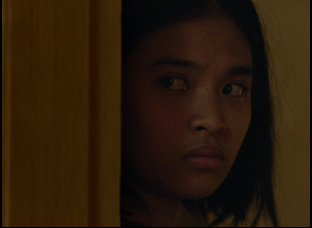This past week at the Thessaloniki Film Festival, “Holy Emy” played before a local crowd in its native Greece, and its star Abagael Loma didn’t know what to think.
“I was very nervous if the audience would like the way I acted or will I get negative feedback,” Loma said of her first performance in any medium, let alone one that would be projected so large. “I never imagined seeing myself on the big screen, so it was like, ‘Wow, what an amazing thing.’”
As unique an experience as it was for the first-time actress, it is equally so for audiences when director Araceli Lemos, recently recognized at the Locarno Film Festival with an award for Best First Feature, ushers one into the Greek-Filipino community for a tale of two sisters Emy (Loma) and Teresa (Hasmine Kilip) whose mother has left for Manila for reasons that remain somewhat shadowy to them and with only patchy FaceTime calls on occasion to connect, the two are left to their own devices to make their way forward in the world where the future doesn’t seem to hold much for them beyond their work at a local fish market. While the seemingly wiser Teresa embraces a more traditional path, seen at first celebrating her 18th birthday as a debutante and attending church, the more timid Emy fears such religious spaces, having an inexplicable habit of bleeding from the eyes whenever she gets close, and although there is never any indication that the supernatural is at play, the power of belief shouldn’t ever be underestimated.
Yet as Luis, a physical therapist Emy begins to work for, tells her, “There is nothing more humbling than a body that doesn’t live up to your desires,” and “Holy Emy” becomes an intriguing exploration of the disconnect between the exterior and interior in all respects, as both Emy and Teresa struggle with having no control over their corporeal form nor do they have much agency as immigrants in a place they can’t easily move away from yet feel entirely restless with their pent-up energy manifesting itself in radically disparate ways. When all the two would seem to have is each other, Lemos looks at how they face the inevitably of growing apart while looking to one another for support, having such a strong bond by birth but having less and less in common by disposition and one can really experience the feeling that it is them against the world when the film immerses audiences in the coastal community the sisters navigate, full of large crowd scenes that underline how challenging it is for Emy and Teresa to find their place in it.
On the eve of the film’s North American premiere at AFI Fest in Los Angeles, Lemos spoke about crafting “Holy Emy” so specifically to the perspective of its characters and authentically capturing the neighborhood she grew up in Ampelokipoi, as well as drawing on the real-life dynamic between her lead actresses and involving the community in the production.
I had the story about two sisters initially in my mind ten years ago, and [how] they had a very unique type of relationship and [how] their relationship had to evolve because they were growing up, and I wanted to explore what made them have such radically different paths, so I felt these two sisters had this [relationship] that was very tight-knit, and in Greece, there would be an interesting mirror between that and the Filipino community, [which is also] tight-knit at the outskirts of the Greek National majority. So this started as an inspiration, but then it started changing so much when I started going to the Filipino church and I got face-to-face with a lot more interesting elements, [such] as the faith and spirituality, and actual stories and life experiences, that was the original beginning of this film.
Giulia Caruso [the co-writer] and I had the backbone of the story, but many times I would find something from going on at the church that we would change, so [for example] a scene that we would change quite close to the shooting was when [the congregation] sings the song “I’ve got spirit in my body that’s keeping me alive,” I heard that very close to the shooting day and I found it was a song that matched the film so much that we integrated it in the scene, so there were a lot of beautiful discoveries along the way.

Yes, and in general that was a production challenge that we shot in very real locations. I had a very strong producing team that had a lot of street experience and even though we’re a modest indie Greek film, we managed to pull off very beautiful, very close-to-life scenes because there was a lot of ground-level work to get the actual people involved in the film and interested, so that we could make real life part of the film instead of fight against it and block it off and recreate it. We tried to use it with all the challenges that that entails, of course.
From what I understand casting Hasmine, who had some acting experience, opposite Abagael, who is in her first role, helped create a dynamic between the sisters. How did that inform this?
Yeah, that was in the heart of the relationship that was built because when I saw Abagael and Hasmine together, they had that very sisterly relationship with Hasmine being experienced and having done films and guiding Abagael and being reassuring for her, knowing what the end of the journey looks like. But also Abagael being able to give the gift of actually having the lived-in experience of being a Greek Filipino and introducing Hasmine to the Filipino world of Greece, they both could lean into each other a lot, and also there were a lot of languages spoken amongst most of the crew, but they always had like a Tagalog as like their own little secret language.

With Ki Ji Kim, my director of cinematography, we have been collaborators since university and we made also my thesis film, so he was always very involved in the language of the film and hand-to-hand as we were writing, so we discussed a lot of how to have these lenses and this [wide] format that allows us to have the intimacy of Emy’s world while always having the present that’s in her periphery, so I also worked with off-screen to have her always know that she is part of worlds that many times she’s alienated from, so these were the ideas that informed the blocking and the framing.
It’s a very atmospheric score as well. What was it like to work on?
Yes, we had the French band Oiseaux-Tempête [as composers] and we had discussed a lot of the motifs [coming] from the environment, so they tried to play with the idea of the real elements to create this inner soundscape. We used very much the idea of the sea that was very present of the port [where Emy and Hasmine live], and we had a strong collaboration with my sound designer and the mixer who were layering this realistic sounds with a kind of inner soundscape that created Emy’s inner reality. It was an elaborate process, but the sound plays a very big part of the film.
What’s it like getting to the finish line?
Yeah, the film premiered in Locarno and it was very nice because all this time, I hadn’t been in a movie theater, so the first movie I saw in a movie theater, and maybe the same for Abagael was “Holy Emy” [laughs] And now we had our Greek premiere and it was the first time that we got a lot of laughter because the Greeks got all of Greek jokes, so it was very nice seeing it with people that had no language barrier, so it’ll be fun to see it with different audiences.
“Holy Emy” will screen at AFI Fest at the TCL Chinese Theater at Hollywood and Highland on November 14th at 7:30 pm.





